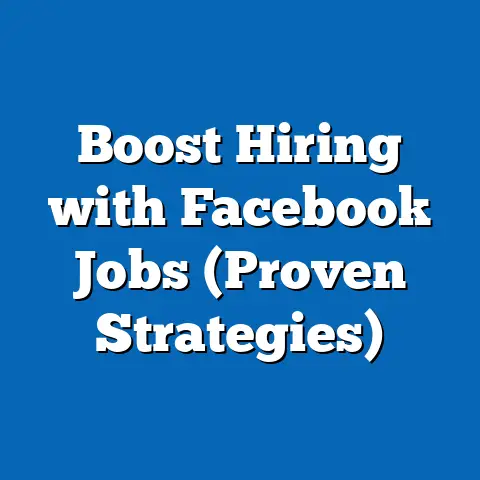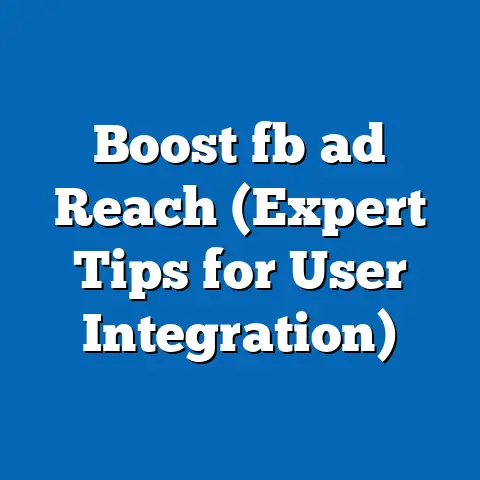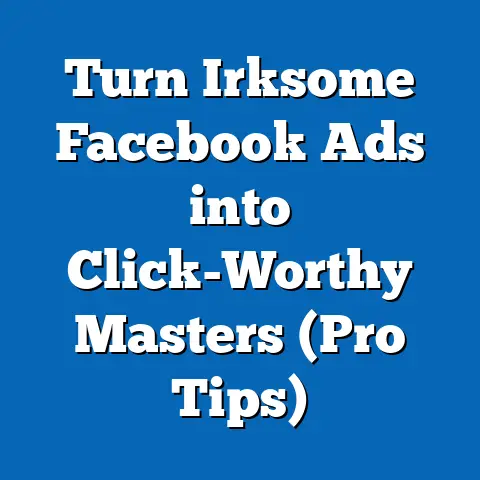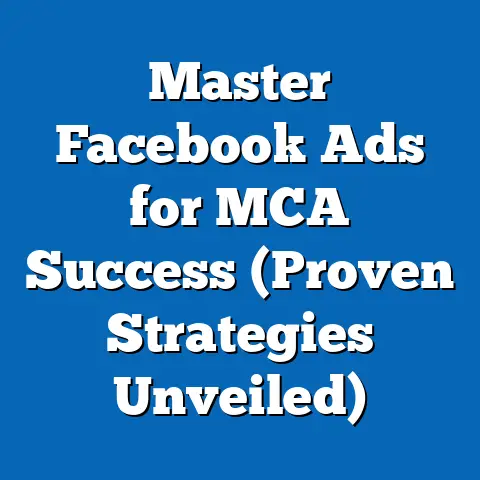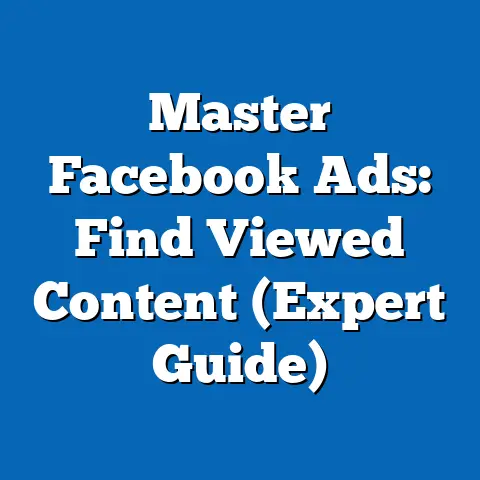Boost Facebook Ads’ Relevance Score (Maximize Impact)
I remember when I first started running Facebook ads. I was so focused on the creative – the perfect image, the wittiest headline – that I completely neglected the relevance score. My ads were running, but they were expensive and not performing well. It felt like throwing money into a black hole. Then, a seasoned colleague pointed out the importance of relevance. That’s when I realized that Facebook prioritizes ads that resonate with their users. Now, a high relevance score is my north star.
Did you know that Facebook is used by over 3 billion people every month? This massive reach makes it an incredible platform for advertisers. However, with so much competition, it’s crucial to ensure your ads stand out and resonate with your target audience. One of the most important factors in achieving this is your ad’s relevance score. In this guide, I’ll break down exactly what a relevance score is, why it matters, and most importantly, provide actionable strategies you can implement today to boost your score and maximize the impact of your Facebook ad campaigns.
Let’s start with a quick win: Focus on your ad targeting. I’ve seen immediate improvements in relevance scores simply by refining my target audience to be more specific and aligned with the ad’s message. It’s often the quickest and easiest way to see results.
Understanding Facebook Ads’ Relevance Score
The relevance score is a metric that Facebook uses to estimate how well your ad resonates with the audience you’re targeting. It’s a number between 1 and 10, with 1 being the lowest and 10 being the highest. Think of it as Facebook’s way of saying, “Hey, this ad is super relevant to these users!” or “Uh oh, this ad is a complete miss.”
But how does Facebook calculate this mysterious score? It’s based on a combination of factors, including:
- Expected Engagement: How likely people are to interact with your ad (likes, shares, comments, clicks).
- Positive Feedback: Whether people are reacting positively to your ad (e.g., liking the page, completing a purchase).
- Negative Feedback: Whether people are hiding your ad or reporting it as spam (this is a big no-no!).
- Landing Page Experience: This is a newer element that assesses how well your landing page matches your ad, and how quickly it loads.
- Quality Ranking: This refers to the perceived quality of your ad compared to other ads targeting the same audience.
- Conversion Rate: For ads optimized for conversions, the rate at which users are completing the desired action (e.g., signing up for a newsletter, making a purchase).
Essentially, Facebook wants to show users ads they’ll find valuable and engaging. The higher your relevance score, the more likely Facebook is to show your ad to a wider audience, and the lower your costs will be.
The Scale and What It Means:
- 1-3: This is a danger zone. Your ad is likely not resonating with your audience. Expect high costs and low performance.
- 4-6: Room for improvement. Your ad is somewhat relevant, but there’s definitely opportunity to optimize.
- 7-8: Good job! Your ad is performing well and resonating with your audience.
- 9-10: Excellent! Your ad is highly relevant and performing exceptionally well. Keep doing what you’re doing!
Why Relevance Score Matters:
The relevance score isn’t just a vanity metric. It has a direct impact on your ad costs and campaign success. A higher relevance score translates to:
- Lower Costs: Facebook rewards relevant ads with lower costs per click (CPC) and cost per thousand impressions (CPM).
- Increased Reach: Facebook is more likely to show your ad to a wider audience if it’s deemed relevant.
- Improved Ad Placement: Relevant ads are more likely to be placed in prime locations, increasing visibility.
- Better ROI: Ultimately, a higher relevance score leads to a better return on your investment.
Takeaway: Understanding the relevance score is crucial for anyone running Facebook ads. It’s a direct indicator of how well your ad is resonating with your target audience, and it has a significant impact on your costs and overall campaign success.
Key Factors Influencing Relevance Score
Now that we know what a relevance score is and why it matters, let’s dive into the key factors that influence it. Think of these as the levers you can pull to optimize your ads for better performance.
1. Targeting: Hitting the Bullseye
Targeting is arguably the most critical factor influencing your relevance score. If you’re showing your ad to the wrong people, it’s simply not going to resonate. Facebook offers a wide range of targeting options, including:
- Demographics: Age, gender, location, education, job title, etc.
- Interests: Hobbies, passions, and things people are interested in.
- Behaviors: Purchase history, device usage, travel habits, etc.
- Custom Audiences: Upload your own customer data (email lists, website visitors) to target specific groups.
- Lookalike Audiences: Find new people who are similar to your existing customers.
The key is to use these targeting options to create a highly specific audience that aligns perfectly with your ad’s message and offer. Broad targeting might seem appealing, but it often leads to lower relevance scores and wasted ad spend.
Example: Let’s say you’re selling vegan protein powder. Targeting everyone interested in “fitness” is too broad. Instead, you should target people interested in “veganism,” “plant-based diets,” “weightlifting,” and “organic food.”
2. Engagement: Sparking Interaction
Engagement is another crucial factor. Facebook wants to see that people are interacting with your ad. This includes:
- Likes: People showing their appreciation for your ad.
- Shares: People sharing your ad with their friends.
- Comments: People engaging in conversations about your ad.
- Clicks: People clicking on your ad to visit your website or landing page.
High engagement signals to Facebook that your ad is valuable and interesting to the audience. To increase engagement, focus on creating compelling content that resonates with your target audience. Ask questions, encourage comments, and run contests or giveaways.
3. Ad Quality: Visuals and Copy That Captivate
The quality of your ad’s visuals and copy plays a significant role in determining its relevance score. High-quality visuals are eye-catching and relevant to your offer. Compelling copy is clear, concise, and persuasive.
- Visuals: Use high-resolution images or videos that are visually appealing and relevant to your target audience. Avoid stock photos that look generic and unauthentic.
- Copy: Write clear, concise, and persuasive copy that highlights the benefits of your offer. Use a strong call to action (CTA) that encourages people to take the next step.
Examples of Ads with High and Low Relevance Scores:
- High Relevance Score: An ad for a local bakery targeting people who live nearby and are interested in “pastries” and “coffee.” The ad features a mouth-watering photo of a freshly baked croissant and offers a special discount for first-time customers.
- Low Relevance Score: An ad for a software company targeting everyone in the United States. The ad features a generic stock photo and vague copy that doesn’t clearly explain the benefits of the software.
Takeaway: Targeting, engagement, and ad quality are the three pillars of a high relevance score. By optimizing these factors, you can significantly improve your ad performance and reduce your costs.
Strategies to Boost Relevance Score
Now, let’s get into the nitty-gritty of how to actually improve your Facebook ad’s relevance score. Here are some actionable strategies you can implement today:
1. Ad Targeting Precision: Zeroing In On Your Ideal Customer
I cannot stress enough how important precise targeting is. It’s not just about reaching more people; it’s about reaching the right people.
- Define Your Target Audience: Start by creating a detailed profile of your ideal customer. Consider their demographics, interests, behaviors, pain points, and goals.
- Leverage Facebook Insights: Use Facebook Insights to gain a deeper understanding of your existing audience. This tool provides valuable data about your followers, including their demographics, interests, and behaviors.
- Create Custom Audiences: Upload your own customer data (email lists, website visitors) to create custom audiences. This allows you to target people who have already shown interest in your business.
- Use Lookalike Audiences: Expand your reach by creating lookalike audiences based on your custom audiences. Facebook will find new people who are similar to your existing customers.
- Layer Targeting Options: Combine multiple targeting options to create a highly specific audience. For example, you could target people who are interested in “yoga” and “meditation” and live in a specific city.
- Exclude Irrelevant Audiences: Don’t be afraid to exclude audiences that are not relevant to your offer. This will help to improve your relevance score and reduce wasted ad spend. For instance, if you’re promoting a product for seniors, exclude younger age groups.
2. Creative Optimization: Crafting Compelling Ads
High-quality visuals and compelling copy are essential for capturing attention and driving engagement.
- Use High-Quality Visuals: Invest in professional photography or videography. Use images and videos that are visually appealing and relevant to your target audience.
- Tell a Story: Use your ad copy to tell a story that resonates with your target audience. Highlight the benefits of your offer and how it can solve their problems.
- Write Clear and Concise Copy: Get straight to the point and avoid jargon. Use clear and concise language that is easy to understand.
- Use a Strong Call to Action (CTA): Tell people what you want them to do. Use a clear and compelling CTA that encourages them to take the next step (e.g., “Shop Now,” “Learn More,” “Sign Up”).
- Optimize for Mobile: The majority of Facebook users access the platform on their mobile devices. Make sure your ads are optimized for mobile viewing.
- Consider Ad Format: Experiment with different ad formats, such as image ads, video ads, carousel ads, and collection ads. Choose the format that best suits your offer and target audience.
3. A/B Testing: Refining Your Ads for Maximum Impact
A/B testing, also known as split testing, is the process of comparing two versions of an ad to see which one performs better. It’s a powerful way to refine your ads and improve your relevance score.
- Choose a Variable to Test: Start by choosing a single variable to test, such as the headline, image, CTA, or targeting options.
- Create Two Versions of Your Ad: Create two versions of your ad, one with the original variable and one with a variation.
- Run Your Ads Simultaneously: Run both versions of your ad simultaneously to the same audience.
- Track Your Results: Track the performance of each ad, paying attention to metrics such as relevance score, click-through rate (CTR), and conversion rate.
- Implement the Winning Version: Once you have enough data, implement the winning version of your ad.
- Repeat the Process: Continue A/B testing different variables to continually improve your ad performance.
Example A/B Tests:
Monitoring ad performance metrics and user feedback is crucial for understanding what’s working and what’s not.
- Monitor Your Ad Performance: Regularly monitor your ad performance metrics, such as relevance score, CTR, conversion rate, and cost per acquisition (CPA).
- Read User Comments: Pay attention to the comments people are leaving on your ads. This can provide valuable insights into what they think about your offer.
- Respond to Feedback: Respond to user comments and questions in a timely manner. This shows that you care about your audience and are willing to address their concerns.
- Adapt Your Ads Based on Feedback: Use the insights you gain from monitoring your ad performance and reading user comments to adapt your ads and improve their relevance.
- Address Negative Feedback: If you’re receiving negative feedback on your ads, take steps to address the issue. This could involve changing your ad copy, improving your targeting, or offering a better product or service.
Takeaway: Boosting your Facebook ad’s relevance score requires a holistic approach that encompasses precise targeting, creative optimization, A/B testing, and continuous feedback and adaptation. By implementing these strategies, you can significantly improve your ad performance and reduce your costs.
Case Studies and Real-Life Examples
Let’s look at a couple of real-life examples where focusing on relevance made a huge difference:
Case Study 1: Local Restaurant
A local Italian restaurant was struggling to attract new customers through Facebook ads. They were running a generic ad targeting everyone within a 10-mile radius. The relevance score was hovering around 3-4, and the cost per click was high.
Solution:
- Targeting: They refined their targeting to focus on people who had expressed an interest in Italian food, dining out, and local restaurants. They also created a custom audience of people who had visited their website.
- Creative: They used high-quality photos of their most popular dishes and wrote compelling copy that highlighted the restaurant’s unique atmosphere and authentic Italian cuisine.
- A/B Testing: They A/B tested different headlines and CTAs to see which ones performed best.
Results:
- The relevance score jumped to 8-9.
- The cost per click decreased by 50%.
- The restaurant saw a significant increase in reservations and foot traffic.
Case Study 2: E-Commerce Store
An e-commerce store selling handmade jewelry was running ads targeting a broad audience interested in “fashion” and “accessories.” The relevance score was low, and the ads were not generating many sales.
Solution:
- Targeting: They segmented their audience based on the type of jewelry they were selling (e.g., necklaces, earrings, bracelets). They also created lookalike audiences based on their existing customers.
- Creative: They used high-quality photos of their jewelry and wrote compelling copy that highlighted the unique craftsmanship and materials used.
- A/B Testing: They A/B tested different product photos and ad copy to see which ones drove the most sales.
Results:
- The relevance score increased to 7-8.
- The conversion rate doubled.
- The e-commerce store saw a significant increase in sales and revenue.
Takeaway: These case studies demonstrate the power of relevance in Facebook advertising. By focusing on precise targeting, creative optimization, and continuous testing, you can significantly improve your ad performance and achieve your business goals.
Conclusion
The relevance score is more than just a number; it’s a compass guiding you toward effective Facebook advertising. By understanding what it is, how it’s calculated, and the factors that influence it, you can take control of your ad campaigns and achieve better results. Remember, a high relevance score translates to lower costs, increased reach, and ultimately, a better return on your investment.
Don’t be afraid to experiment with different targeting options, creative elements, and A/B testing strategies. Continuously monitor your ad performance and adapt your ads based on feedback. By following the strategies outlined in this guide, you can boost your Facebook ads’ relevance score and maximize the impact of your campaigns.
So, what are you waiting for? Start implementing these strategies today and watch your relevance scores soar! I encourage you to share your experiences with Facebook ads in the comments section below. What strategies have worked best for you? What challenges have you faced? Let’s learn from each other and build a community of successful Facebook advertisers.

